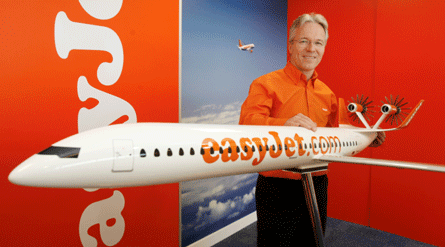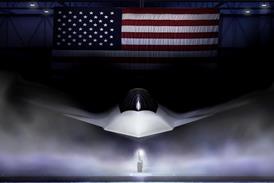UK budget carrier EasyJet has revealed an aircraft design concept, which it claims could deliver 50% improvements to fuel efficiency and carbon dioxide emissions.

A model of the 'EasyJet EcoJet' concept aircraft, which features two rear-mounted open rotor engines integrated into the tail plane, was presented by EasyJet CEO Andrew Harrison during a press conference on the sidelines of the Low Cost Air Transport Summit in London this morning.
The budget carrier has designed the aircraft internally off the back of the latest airframer and engine manufacturer technologies, claiming that it could be ready for operation by 2015.
Harrison says: "The technology is already there to deliver the next step change. This is not Star Trek, this is within our grasp.
"This is what the next generation of aircraft will look like and we are working with the manufacturers to get this technology delivered in 2015."
EasyJet says that the concept, compared with modern aircraft like the Airbus A320 or Boeing 737, would be 25% quieter and 50% more fuel efficient, while producing 50% less carbon dioxide and 75% less NOx.
Integrated high into the tail plane to reduce ground noise, the open rotor engines will deliver a 25% CO2 and fuel efficiency improvement, claims EasyJet.
The type's fuselage and wings would be manufactured from lightweight composite materials, like those used on the Boeing 787, delivering a further 15% in efficiencies. The wings have the latest laminar flow technology and are located further aft than current designs to balance the weight of the engines.
A further 10% in fuel efficiency and CO2 gains would stem from the type's avionics, linked with the latest air traffic control technologies.
Harrison says: "We are talking to Boeing and Airbus. Both manufacturers are working on the next generation of aircraft. This design, that we are talking to the manufacturers about, wouldn't be certified, but a lot of aeronautical engineering has gone into developing this model."
He says that it is proving difficult to pin Boeing and Airbus down to a delivery date for their new single aisle aircraft, but says that airline demand could push them into action to achieve his 2015 target.
"What we are saying to them is that this is what we, the customer, want you to build. Get on with it and develop it by 2015," says Harrison.
Embraer has not been included in the talks, as Harrison believes that the Brazilian manufacturer's aircraft would be too small for EasyJet's needs.
He adds that China is an unlikely design source for the concept aircraft, although the country may be used by Airbus or Boeing for final production.
EasyJet has designed the aircraft internally, with no direct input from Boeing or Airbus. But an EasyJet spokesman says that the manufacturers have seen images of the design. He adds that there is nothing on the concept design which would be unfamiliar to the manufacturers.
Harrison says: "Airbus is going to be six to seven years behind in the battle for the mid-range aircraft. What we are saying to Airbus is make sure you're ready in the battle for short-haul aircraft.
"We are spending £4 billion on aircraft. They are listening to us."
A small team of trained aeronautical engineers within EasyJet designed the concept.
One of the designers, who confesses to being a little "rusty" in his aeronautical engineering skills, says: "We are more active in airlines than in aeronautical engineering, but we think that it's credible."
Related pictures
Related blog
Related stories
Source: FlightGlobal.com























